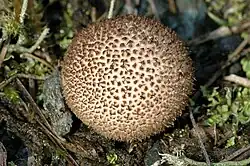Lycoperdon nigrescens
| Lycoperdon nigrescens | |
|---|---|

| |
| A similar species. L. nigrescens is darker between the spines. | |
| Scientific classification | |
| Kingdom: | Fungi |
| Division: | Basidiomycota |
| Class: | Agaricomycetes |
| Order: | Agaricales |
| Family: | Lycoperdaceae |
| Genus: | Lycoperdon |
| Species: | L. nigrescens
|
| Binomial name | |
| Lycoperdon nigrescens Wahlenb. (1794)
| |
| Synonyms | |
|
Lycoperdon foetidum Bonord. | |
| Lycoperdon nigrescens | |
|---|---|
| Glebal hymenium | |
| No distinct cap | |
| Hymenium attachment is irregular or not applicable | |
| Lacks a stipe | |
| Spore print is olive | |
| Ecology is saprotrophic | |
| Edibility is unknown | |
Lycoperdon nigrescens, with the synonym Lycoperdon foetidum, commonly known as the dusky puffball,[1] is a type of puffball mushroom in the genus Lycoperdon. It was first described scientifically in 1794 by the Swedish naturalist Göran Wahlenberg.[2]
The fruit body grows up to 6 centimetres (2+1⁄4 in) tall and 4 cm (1+1⁄2 in) wide.[3] The caps are shaped somewhat like pears, with spines ranging in brightness, which later break off.[4] The surface is dark between the spines. The stipe has thin strands coming from its base.[4] Visually similar to other species when young, it grows increasingly darker with age and lacks the pronounced stipe that old Lycoperdon perlatum specimens attain.[5]
It appears from summer to fall in both conifer and hardwood forests, in addition to alpine areas.[4] Its edibility is unknown, but related puffballs are edible in youth, when still firm and white inside.[3]
References
- ^ Phillips R. (2013). Mushrooms: A Comprehensive Guide to Mushroom Identification. Pan Macmillan. p. 330. ISBN 978-1-4472-6402-6.
- ^ "Lycoperdon nigrescens Wahlenb. 1794". MycoBank. International Mycological Association. Retrieved 2014-07-13.
- ^ a b Arora, David (1986) [1979]. Mushrooms Demystified: A Comprehensive Guide to the Fleshy Fungi (2nd ed.). Berkeley, California: Ten Speed Press. pp. 692–93. ISBN 978-0-89815-170-1.
- ^ a b c Trudell, Steve; Ammirati, Joe (2009). Mushrooms of the Pacific Northwest. Timber Press Field Guides. Portland, OR: Timber Press. p. 269. ISBN 978-0-88192-935-5.
- ^ ""Matchmaker Mushroom Identification"". 2019.
External links